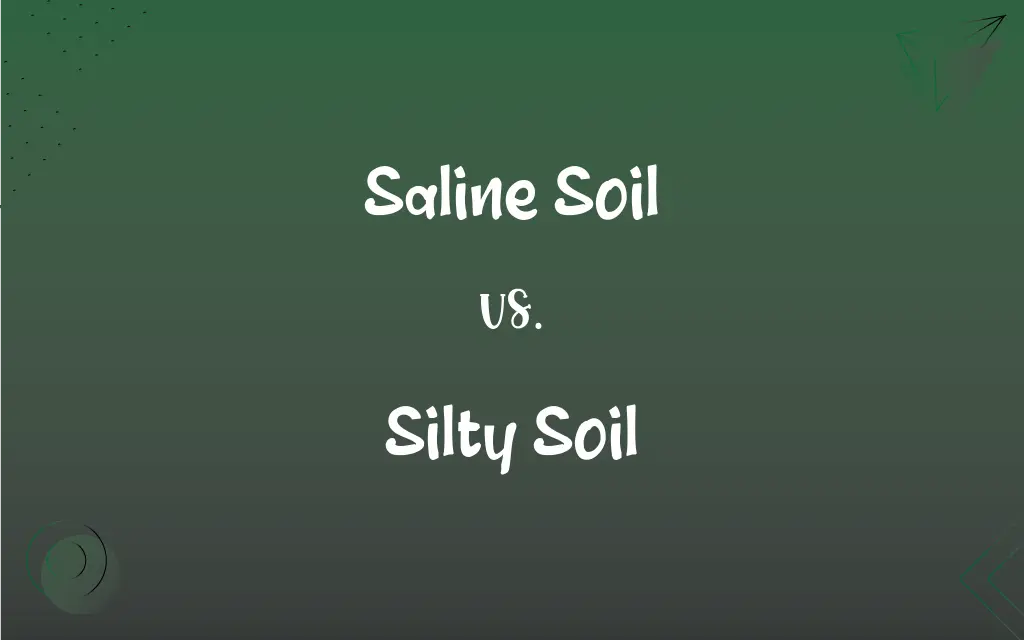Saline Soil vs. Silty Soil: What's the Difference?
Edited by Aimie Carlson || By Harlon Moss || Updated on October 25, 2023
Saline soil contains high salt concentrations, while silty soil is fine-grained with smooth textures.

Key Differences
Saline soil is characterized by a significant presence of soluble salts, mainly sodium, calcium, and magnesium. Silty soil, on the other hand, is recognized by its fine particles and is typically smooth to the touch, often likened to the feel of flour or talcum powder.
The presence of excessive salts in saline soil can be detrimental to many plants, causing issues like water uptake hindrance and nutrient imbalances. In contrast, silty soil, being composed of fine particles, tends to retain moisture well, which can be beneficial for certain crops but may also cause poor drainage.
Saline soil often originates in regions with low rainfall, where the evaporation rate exceeds precipitation, leading to salt accumulation. Silty soil typically forms from the sedimentation of fine organic and inorganic particles carried by moving water, eventually settling in calm water bodies or areas.
Testing the salinity of soil can help in determining its suitability for various crops. Silty soil's texture can be assessed through simple touch and feel, determining its water retention and drainage capabilities.
Despite their distinctive properties, both types of soils can be managed and amended to improve their quality. For saline soils, this could mean flushing out salts with ample irrigation or using salt-tolerant crops. For silty soils, organic matter can be added to improve structure and drainage.
ADVERTISEMENT
Comparison Chart
Origin
Result of high salt concentrations
Sedimentation of fine organic particles
Texture
Varies but defined by salt content
Smooth and fine-grained
Water Retention
Can hinder water uptake in plants
Retains moisture well
Formation
Common in low rainfall areas
Settles in calm water bodies or areas
Management
Flushing with water, using salt-tolerant crops
Add organic matter for better drainage
ADVERTISEMENT
Saline Soil and Silty Soil Definitions
Saline Soil
Saline soil may require management techniques to reduce salt content.
Flushing the saline soil with ample water helped reduce its salinity.
Silty Soil
Silty soil retains moisture effectively.
The plants thrived in the silty soil due to its excellent moisture retention.
Saline Soil
High salinity can impact soil structure and fertility.
The persistent salinity in the soil reduced its fertility over time.
Silty Soil
Silty soil can be easily compacted.
Walking regularly over the garden bed compacted the silty soil, making it harder for roots.
Saline Soil
Saline soil commonly forms in arid regions.
The desert areas often have patches of saline soil, affecting agriculture.
Silty Soil
Silty soil originates from sedimentation processes.
The riverbanks often have silty soil formed by sedimentation over time.
Saline Soil
Saline soil is rich in soluble salts.
The crops struggled to grow in the saline soil due to excessive salt content.
Silty Soil
Silty soil can sometimes have drainage issues.
Due to its fine texture, the silty soil in the yard often became waterlogged.
Saline Soil
Saline soil can hinder plants' water uptake.
Farmers had to select salt-tolerant plants for the saline soil of their land.
Silty Soil
Silty soil has fine, smooth-textured particles.
The garden bed felt smooth, indicating the presence of silty soil.
FAQs
How does silty soil feel to touch?
Silty soil feels smooth and fine-grained, similar to flour.
Does silty soil drain well?
Silty soil tends to retain moisture, which can sometimes lead to poor drainage.
How does saline soil form?
It often forms in areas with low rainfall where evaporation exceeds precipitation, causing salt accumulation.
Are there any visual indicators of saline soil?
White or crusty salt deposits on the soil surface can indicate salinity.
Do plants show specific symptoms in saline soil?
Plants in saline soil may show stunted growth, leaf burn, or yellowing.
Is silty soil acidic or alkaline?
Silty soil's pH can vary, but it's typically neutral to slightly acidic.
Are there plants that prefer silty soil?
Many plants like silty soil due to its moisture retention, including willows and river birch.
What defines saline soil?
Saline soil is characterized by high concentrations of soluble salts.
Is saline soil good for all plants?
No, many plants struggle in saline soil, but some salt-tolerant crops can thrive.
What's the pH level of saline soil?
Saline soil can have a varied pH but is often alkaline due to the presence of salts.
How does salinity affect soil structure?
High salinity can cause soil particles to disperse, affecting its structure.
Is silty soil good for potted plants?
While it retains moisture, proper drainage is crucial for potted plants in silty soil.
How can one reduce salinity in soil?
Leaching the soil with ample water can help flush out excess salts.
Is erosion a concern for silty soil?
Yes, silty soil is prone to erosion due to its fine texture.
Can saline soil affect groundwater?
Yes, excessive irrigation on saline soil can leach salts into groundwater.
How is silty soil formed naturally?
It forms from the sedimentation of fine organic and inorganic particles in calm waters.
How can one improve silty soil's drainage?
Adding organic matter can help improve drainage in silty soil.
What's the main challenge with silty soil in gardening?
Ensuring proper drainage is vital to prevent waterlogging in silty soil.
What's the origin of silty soil?
Silty soil forms from sedimentation of fine particles in calm water bodies.
Can saline soil be improved for farming?
Yes, by flushing salts with water or using salt-tolerant crops.
About Author
Written by
Harlon MossHarlon is a seasoned quality moderator and accomplished content writer for Difference Wiki. An alumnus of the prestigious University of California, he earned his degree in Computer Science. Leveraging his academic background, Harlon brings a meticulous and informed perspective to his work, ensuring content accuracy and excellence.
Edited by
Aimie CarlsonAimie Carlson, holding a master's degree in English literature, is a fervent English language enthusiast. She lends her writing talents to Difference Wiki, a prominent website that specializes in comparisons, offering readers insightful analyses that both captivate and inform.































































